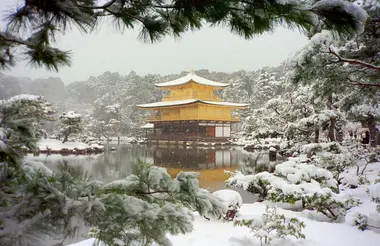The best Japanese winter scenery 日本の冬の景色
Scenes of snowy Japan
In Japan, winter is a season as beautiful as spring, summer or autumn. Under low temperatures and with a bit of luck, under the snow, discover the traditional places to visit during the winter season!
Mount Fuji
Mount Fuji, the ancestral symbol of Japan, is a place to visit at least once during your stay in Japan. Popularized by media such as magazines and documentaries, but also by art through paintings and prints, the beauty of this mountain is fascinating.
3776 meters high, Mount Fuji is composed of 3 active volcanoes which could wake up one day. Its beauty would almost make us forget this detail.
Mount Fuji is also the most climbed mountain in the world! Although the official climbing season lasts only a little more than two months, Mount Fuji welcomes nearly 300,000 climbers every year. This figure is much higher than that of Mount Monadnock in the United States, the second most climbed mountain with about 125,000 people per year. The possibility to climb it in half a day explains in part this success.
Located between Yamanashi and Shizuoka, and close to Tokyo, this Japanese mountain has inspired many artists for centuries, including the master of the print Hokusai.
Read also: Mount Fuji in history, culture, and art
Le village de Shirakawago
Located in Gifu prefecture (50 minutes from Takayama), the traditional village of Shirakawago, surrounded by mountains, is classified as a UNESCO World Heritage Site since 1995.
The success of this village lies in the appearance of its houses, which are built according to the gassho-zukuri style, specific to the region. It can be recognized by its ancient houses with thatched roofs, which help to resist the heavy snowfalls during the winter.
The houses are arranged throughout the village, separated by rice fields and connected by elevated paths. It is in winter that many locals and tourists wish to visit the place when the snow covers the village and the houses are illuminated.
The view of the shimmering rice fields and the old houses from the top of the hill gives a unique view of Japan.
Stay in one of our traditional rental houses in Takayama
Kenroku-en garden
The Kenroku-en garden located in Kanazawa is one of the three most famous gardens in Japan, together with the Kairaku-en in Mito and the Kôraku-en in Okayama.
With nearly 8,200 trees in 10 hectares of land, it is a natural area worth visiting. After the autumn season, the garden is even more remarkable when the winter season takes over.
The garden is world-famous for the care taken with the plants, the pruning of the pruned trees and the beauty of the snow-covered yukitsuri.
From the beginning of November, the Karasaki Matsu pines are adorned with yukitsuri, ropes that protect these ancient trees before the onset of winter, in anticipation of the damage that the heavy snowfall of the Nihonkai might cause.
At nightfall, the garden is illuminated and the yukitsuri are also illuminated until the end of winter.
Stay in one of our Kanazawa houses rentals
Ginzan Onsen
Onsen, or hot springs, are a real institution in Japan. These hot baths, whose water comes from volcanic springs, have been known for centuries to have a certain therapeutic value.
In Yamagata prefecture, a former silver mine has become one of the most popular spas for onsen lovers in winter: Ginzan Onsen (ginzan = silver mine).
We have to admit that the very special atmosphere of this village of Tohoku region is very pleasant! The city is composed of only one street, lined with ryokan and traditional wooden buildings dating from Taisho era (1912 - 1926) and Shôwa era (1926-1989).
Each ryokan allows access to its onsen without the obligation to rent a room. In this case, count between 300 and 1,500 yen (between 2 and 12 € approximately).
Two public baths, with an entrance fee of 300 to 500 yen (between 2 and 4 €), are open in the center of the city, as well as a free foot bath.
At nightfall, gas lamps light up to shed a beautiful light on the freshly fallen snow.
- See also: Five onsen for the winter
Jigokudani Yaen koen
Jigokudani Monkey Park is located in the Yokoyugawa Valley in Nagano. At Jigokudani Onsen, it is possible to observe wild monkeys (Japanese macaques) basking in the water of a natural hot spring. At 850 meters above sea level, it is cold, -10°, and the snow covers everything, up to one meter thick to make this picture a classic of Japan in winter.
This park was created in 1964 when monkeys from the mountain came down to the villages because of deforestation. One day, a small monkey comes to bathe in the outdoor onsen of a ryokan, then his whole family. To promote good cohabitation with humans, a special bath was arranged for them, and for the happiness of all.
Kinkaku-ji Temple
The Golden Pavilion Temple, Kinkakuji, whose real name is Rokuon-ji, is undoubtedly the flagship temple among all those in Kyoto.
Entirely covered with gold leaf (except for the first floor), it shines brightly.
If you are lucky enough to go there just after a snowfall, the fine contrast of the gold with the immaculate white and green of nature reflecting in the water will be memorable!
Kinkaku-ji has been a UNESCO World Heritage Site since 1994 as an iconic historical monument of ancient Kyoto.























